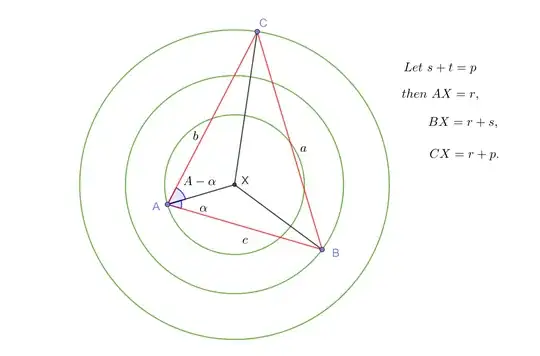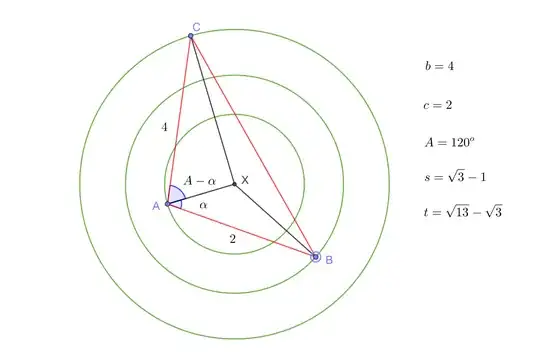I have been struggling finding an analytic solution to the following geometry problem:
Consider an acute triangle $ABC$ (with all sides and angles known), with some unknown point $X$ in its interior. Denoting the (unknown) distances from the vertices to this interior point by $AX$, $BX$, and $CX$ (for simplicity assume $AX < BX < CX$), we are given the values of $s = BX-AX$, and $t = CX-BX$. We want to find $AX$. (I believe this should entirely pin down everything, see discussion later).
A way to illustrate this is to draw three circles with center $X$ and radii $AX$, $BX (= AX + s)$ and $CX (= AX + s + t)$ respectively.
Alternatively we can draw these circles with their centerpoints at $A$, $B$ and $C$ instead, which gives us $X$ as their intersection point:

Now if we imagine varying the radius of the smallest circle $(AX)$, and always keeping the radii of the other two circles $AX + s$ and $AX + s + t$ respectively, then there should be(?) a unique value for $AX$ where all three circles intersect, and thus the point $X$ is uniquely determined. So although I'm pretty convinced there should be a unique solution, I'm struggling to actually derive an analytic formula for the answer.
I did try using pythagoras' theorem a bunch on a picture like this:

However I didn't seem to get very far, I just got kinda lost in the formulas. Is it possible to find a formula for the distance $AX$?
As a sidenote, during digging through the formulas I discovered that in this setup (interior point in acute triangle with normals splitting all three sides), we get that $a^2 + b^2 + c^2 = (a')^2 + (b')^2 + (c')^2$ is satisfied. Does this result have a name? Can it be generalized? (What happens with non-interior points, obtuse triangles, is this condition satisfied if and only if the sides are split by a point in such a way?)

